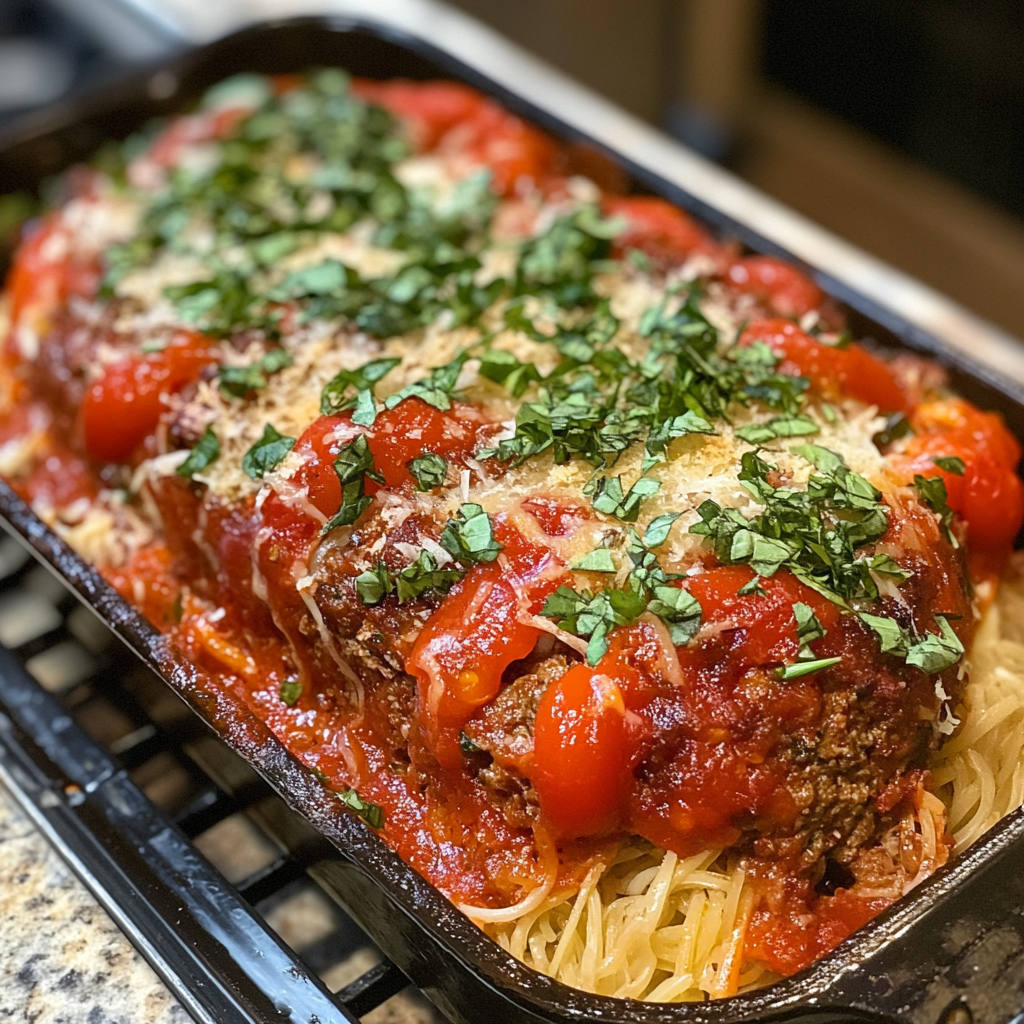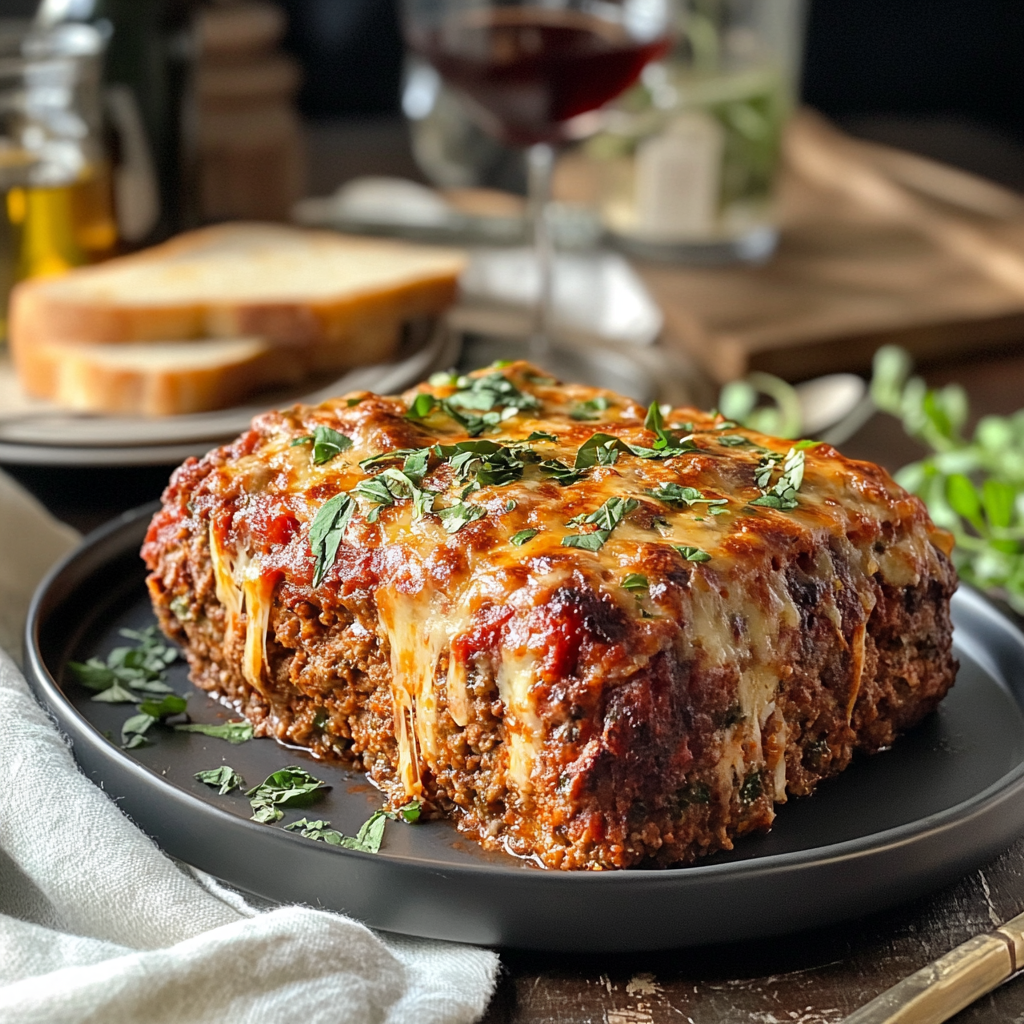Italian meatloaf, or Polpettone, is a comforting and flavorful twist on the classic American meatloaf. Packed with authentic Italian flavors, this dish combines ground beef, Italian sausage, Parmesan cheese, herbs, and a rich tomato glaze for an unforgettable meal.
Whether you’re looking for a hearty family dinner, a make-ahead meal, or a dish to impress your guests, this Italian-style meatloaf delivers a perfect balance of savory, cheesy, and herb-infused goodness.
Let’s dive into the origins, ingredients, and what makes Italian meatloaf so special.
What Makes Italian Meatloaf Different?
Unlike traditional American meatloaf, which often relies on ketchup-based toppings and plain breadcrumbs, Italian meatloaf incorporates:
- High-quality meats – a mix of beef, pork, and veal for a rich texture.
- Italian sausage – adds depth, spice, and a touch of fennel.
- Herbs and seasonings – fresh basil, oregano, parsley, and garlic for an unmistakable Mediterranean taste.
- Cheese – Parmesan, mozzarella, or ricotta for creaminess.
- Tomato-based sauce – instead of ketchup, Italian meatloaf is topped with homemade marinara or tomato glaze.
This fusion of Italian ingredients makes it juicier, more flavorful, and far more exciting than traditional meatloaf.
The History of Italian Meatloaf (Polpettone)
The Italian word “Polpettone” means “large meatball,” which is exactly what this dish is—a giant, flavorful meatball baked to perfection.
While meatloaf in America became popular in the 19th century, Italian meatloaf has been around for centuries, originating as a peasant dish in regions like Tuscany and Sicily.
- In northern Italy, it’s common to find stuffed Polpettone with boiled eggs or mozzarella.
- In southern Italy, it’s flavored with spicy sausage, sun-dried tomatoes, and Pecorino cheese.
- Some versions are wrapped in prosciutto or baked in wine-infused sauce for extra richness.
No matter the variation, Polpettone remains a cherished dish across Italy, often served on Sundays or special family gatherings.
Key Ingredients for an Authentic Flavor
A great Italian meatloaf starts with high-quality ingredients. Here’s what you’ll need for maximum flavor:
Choosing the Right Ground Meat
A combination of meats creates the perfect balance of texture and taste. The best mix includes:
- 80% lean ground beef – for richness and structure.
- Ground pork or Italian sausage – adds fat and bold flavors.
- Veal (optional) – for extra tenderness.
If you prefer a leaner version, substitute pork with ground turkey while adding olive oil for moisture.
The Role of Italian Herbs and Spices
Fresh herbs elevate the taste of the meatloaf. Essential seasonings include:
- Garlic – finely minced for depth.
- Fresh parsley – brightens the dish.
- Oregano & basil – bring signature Italian flavors.
- Red pepper flakes – for a subtle heat (optional).
Using the Right Cheese
Cheese is a game-changer in Italian meatloaf. The best options include:
- Parmesan – for a sharp, nutty flavor.
- Mozzarella – makes it gooey and cheesy.
- Ricotta – adds moisture and creaminess.
For an extra cheesy experience, try stuffing the meatloaf with mozzarella!
Best Breadcrumbs for Italian Meatloaf
Breadcrumbs help bind the meatloaf together. Here’s what works best:
- Italian-seasoned breadcrumbs – pre-mixed with herbs.
- Panko breadcrumbs – for a lighter texture.
- Fresh breadcrumbs – homemade from Italian bread for authenticity.
For a low-carb version, replace breadcrumbs with almond flour or crushed pork rinds.
Tomato Sauce vs. Marinara Topping
Instead of ketchup, Italian meatloaf is smothered in tomato sauce. Your best options:
- Homemade marinara – made with tomatoes, garlic, olive oil, and basil.
- Classic tomato sauce – slightly thicker and richer.
- Tomato paste mixed with red wine – for deep, bold flavors.
Secret Ingredients for Extra Flavor
Want to take your meatloaf to the next level? Try adding:
- Sun-dried tomatoes – for a burst of sweetness.
- Roasted garlic – enhances depth.
- A splash of red wine – intensifies the flavor.
Step-by-Step Cooking Instructions for Italian Meatloaf
Now that we have covered the history and essential ingredients, it’s time to prepare and cook the ultimate Italian meatloaf. This step-by-step guide will help you achieve a moist, flavorful, and perfectly baked Polpettone.
Preparing the Meat Mixture
A well-mixed meat base is the foundation of a great meatloaf. Follow these steps for the best results.
1. Gather Your Ingredients
Before starting, make sure you have all the necessary ingredients:
- 1 pound ground beef (80% lean)
- ½ pound Italian sausage (mild or spicy, casing removed)
- 1 cup Italian-seasoned breadcrumbs
- ½ cup grated Parmesan cheese
- 2 large eggs
- ½ cup whole milk
- 2 tablespoons fresh parsley, chopped
- 1 teaspoon garlic powder
- 1 teaspoon dried oregano
- ½ teaspoon red pepper flakes (optional)
- Salt and black pepper to taste
2. Mixing for the Perfect Texture
- In a large mixing bowl, combine the ground beef and Italian sausage.
- Add breadcrumbs, Parmesan cheese, eggs, and milk to help bind the meat mixture together.
- Sprinkle in fresh parsley, oregano, garlic powder, and red pepper flakes for added flavor.
- Mix gently using your hands or a spatula. Be careful not to overmix, as this can make the meatloaf dense and tough. The ingredients should be evenly combined without becoming too compact.
Adding the Flavor Enhancers
3. Incorporating Cheese for Extra Creaminess
To ensure the meatloaf stays moist and flavorful, mix in:
- ½ cup shredded mozzarella (for a rich, gooey texture)
- ¼ cup ricotta cheese (for added moisture and softness)
For an extra indulgent version, set aside additional mozzarella to stuff in the center before baking.
Shaping and Stuffing the Meatloaf
4. Forming the Perfect Shape
- Line a baking sheet with parchment paper or lightly grease a loaf pan.
- Transfer the meat mixture onto the sheet and shape it into a loaf approximately 10 inches long and 4 inches wide.
5. Making a Mozzarella-Stuffed Meatloaf (Optional)
For a deliciously cheesy center, follow these steps:
- Flatten the meat mixture into a rectangular shape.
- Place a row of mozzarella slices in the center.
- Roll the meat around the cheese, sealing the edges firmly to prevent melting cheese from leaking out.
Baking Techniques for Perfect Texture
6. Choosing the Right Oven Temperature
Preheat the oven to 375°F (190°C). This temperature ensures even cooking without drying out the meat.
7. Preventing Dryness in Meatloaf
To keep the meatloaf juicy and tender:
- Add a small amount of olive oil to the mixture before baking.
- Bake uncovered for the first 20 minutes, then cover loosely with foil to prevent excessive browning.
- Place a small dish of water in the oven to maintain moisture.
8. Checking for Doneness
Using a meat thermometer is the most accurate way to check if the meatloaf is fully cooked.
- The internal temperature should reach 160°F (71°C).
- If a thermometer is not available, slice into the thickest part of the meatloaf to check. The interior should be fully cooked, with no visible pink.
Making the Perfect Tomato Glaze
A rich and tangy tomato glaze enhances the flavor of Italian meatloaf.
9. Simple Homemade Tomato Sauce
Ingredients:
- 1 cup crushed tomatoes
- 2 cloves garlic, minced
- 2 tablespoons red wine (optional)
- 1 tablespoon olive oil
- 1 teaspoon dried basil
- 1 teaspoon dried oregano
- Salt and black pepper to taste
Instructions:
- Heat olive oil in a pan over medium heat, then sauté garlic until fragrant.
- Add crushed tomatoes, red wine, and dried herbs.
- Simmer the sauce for 10 to 15 minutes until it thickens slightly.
- Pour the sauce over the meatloaf during the final 10 minutes of baking for a rich, flavorful coating.
Resting and Slicing for Best Results
10. Why Resting is Important
Once the meatloaf is removed from the oven, allow it to rest for at least 10 minutes before slicing.
This step is crucial because:
- It allows the juices to redistribute throughout the meatloaf, keeping it moist.
- It prevents the meatloaf from falling apart when sliced.
11. Slicing the Meatloaf Correctly
Use a sharp knife and cut the meatloaf into thick slices, about ¾ inch each. This ensures a firm and even texture in every portion.

Serving Suggestions
Italian meatloaf pairs well with a variety of side dishes that complement its robust flavors.
12. Best Side Dishes for Italian Meatloaf
- Pasta – Serve with spaghetti and marinara sauce for a classic Italian combination.
- Garlic mashed potatoes – Creamy and buttery mashed potatoes enhance the meatloaf’s richness.
- Garlic bread – Perfect for soaking up extra sauce.
- Roasted vegetables – Zucchini, bell peppers, and asparagus provide a fresh contrast to the hearty meat.
- Red wine – A medium-bodied Chianti or Sangiovese pairs well with the dish.
13. Garnishing and Presentation Tips
- Sprinkle freshly chopped basil or parsley on top for a fresh, vibrant look.
- Add a light dusting of grated Parmesan cheese for extra depth of flavor.
- Serve on a rustic wooden board with a small bowl of extra marinara sauce on the side for dipping.
Variations, Storage, and Nutrition of Italian Meatloaf
Now that you have mastered the classic Italian meatloaf recipe, let’s explore exciting variations, best storage practices, and nutritional information. Whether you want to try a stuffed version, make a healthier alternative, or learn how to store leftovers, this section covers everything you need.
Delicious Variations of Italian Meatloaf
Italian meatloaf is versatile, allowing for different ingredients and flavors. Here are some popular variations:
1. Mozzarella-Stuffed Italian Meatloaf
For a cheesy surprise inside, try stuffing your meatloaf with fresh mozzarella.
How to Make It:
- Flatten the meat mixture before shaping it.
- Place slices of mozzarella or shredded mozzarella in the center.
- Roll the meatloaf around the cheese, sealing the edges tightly.
- Bake as usual, ensuring the cheese melts into the meat for a rich, gooey texture.
This version pairs well with extra marinara sauce for dipping.
2. Spicy Italian Meatloaf
For a bolder, spicier version, add a kick of heat with these simple adjustments:
- Use hot Italian sausage instead of mild.
- Add 1 teaspoon of crushed red pepper flakes to the meat mixture.
- Incorporate chopped Calabrian chili peppers for authentic Italian heat.
This variation is perfect for those who enjoy spicy Italian dishes like Arrabbiata sauce.
3. Keto and Low-Carb Italian Meatloaf
For a low-carb or keto-friendly version, replace traditional breadcrumbs with almond flour or crushed pork rinds.
Other keto-friendly substitutions:
- Use grated Parmesan cheese as a binder instead of breadcrumbs.
- Replace milk with heavy cream to maintain richness.
- Serve with roasted vegetables or cauliflower mash instead of pasta.
This version is ideal for those following a low-carb lifestyle while still enjoying a delicious Italian meal.
Leftovers and Storage Tips
Proper storage ensures that Italian meatloaf remains fresh and flavorful when reheated.
4. Best Practices for Refrigerating Italian Meatloaf
- Allow the meatloaf to cool completely before storing.
- Wrap tightly in plastic wrap or aluminum foil to prevent moisture loss.
- Store in an airtight container in the refrigerator.
- Consume within 3 to 4 days for the best flavor.
5. Can You Freeze Italian Meatloaf?
Yes! Freezing meatloaf is a great way to meal prep for future dinners.
How to Freeze Italian Meatloaf:
Uncooked Meatloaf:
- Shape the meat mixture into a loaf.
- Wrap tightly in plastic wrap and then aluminum foil.
- Store in a freezer-safe bag for up to 3 months.
- Thaw in the refrigerator overnight before baking.
Cooked Meatloaf:
- Allow the meatloaf to cool completely.
- Slice into individual portions for easy reheating.
- Wrap slices in parchment paper and store in an airtight container.
- Freeze for up to 3 months.
6. Reheating Without Losing Moisture
To maintain a juicy texture, use one of these methods:
- Oven: Bake at 325°F (165°C) for 15 minutes, covered with foil to prevent drying.
- Stovetop: Reheat in a skillet with a few tablespoons of water or marinara sauce over low heat.
- Microwave: Heat in 30-second intervals with a damp paper towel covering the meatloaf to retain moisture.
Avoid reheating at high temperatures, as this can dry out the meat.
Nutritional Information and Health Benefits
7. Calories and Macronutrients
A typical serving of Italian meatloaf (without pasta or sides) contains approximately:
- Calories: 350-450 per serving
- Protein: 30-35 grams
- Fat: 20-25 grams
- Carbohydrates: 10-15 grams (varies based on breadcrumbs used)
- Fiber: 1-2 grams
8. Making a Healthier Version
To lighten up the recipe without sacrificing flavor, try these substitutions:
- Use lean ground turkey or chicken instead of beef and pork.
- Replace whole milk with unsweetened almond milk or low-fat milk.
- Reduce cheese or use part-skim mozzarella instead of full-fat versions.
- Serve with a side salad instead of pasta to cut down on carbs.
These small changes create a lower-calorie, higher-protein version while keeping the delicious Italian flavors intact.
Common Mistakes to Avoid
9. Overmixing the Meat Mixture
Overmixing leads to dense, tough meatloaf. Mix until just combined to keep it tender.
10. Skipping the Resting Time
Slicing the meatloaf immediately after baking causes juices to escape, making it dry. Always let it rest for 10 minutes before cutting.
11. Not Using a Meat Thermometer
Guessing when the meatloaf is done can lead to undercooked or overcooked results. A meat thermometer ensures the perfect internal temperature of 160°F (71°C).
12. Using Too Many Breadcrumbs
Excess breadcrumbs absorb moisture, making the meatloaf too dry. Stick to 1 cup per pound of meat for the best balance.
13. Skipping the Sauce
The tomato glaze or marinara topping adds extra moisture and flavor. Without it, the meatloaf can taste bland.
Frequently Asked Questions (FAQs)
1. Can I make Italian meatloaf without breadcrumbs?
Yes. You can substitute breadcrumbs with almond flour, crushed pork rinds, or grated Parmesan for a low-carb version.
2. What is the best meat for Italian meatloaf?
A mix of ground beef, Italian sausage, and veal creates the most flavorful and juicy meatloaf.
3. How can I keep my meatloaf from falling apart?
Make sure to use enough eggs and breadcrumbs as binders, and let the meatloaf rest before slicing.
4. Can I prepare meatloaf ahead of time?
Yes. You can assemble it the night before, cover it tightly, and refrigerate it until ready to bake.
5. What can I use instead of milk?
You can use beef broth, almond milk, or heavy cream for added moisture.
6. Should I cook the meatloaf covered or uncovered?
Start baking uncovered for 20 minutes, then cover loosely with foil to retain moisture.
7. What sauce goes best with Italian meatloaf?
Homemade marinara sauce or a tomato glaze made with crushed tomatoes and garlic works best.
8. Can I cook Italian meatloaf in an air fryer?
Yes. Cook at 350°F (175°C) for 25-30 minutes, checking for an internal temperature of 160°F (71°C).
9. How long does Italian meatloaf last in the fridge?
Properly stored, it stays fresh for 3 to 4 days.
10. Can I use turkey instead of beef?
Yes. Ground turkey works well but may need extra seasoning and moisture, such as olive oil or ricotta cheese.

